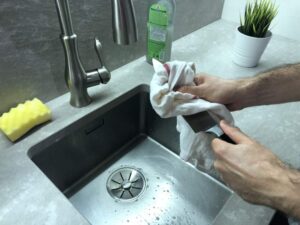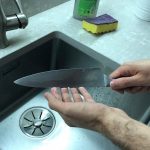We don’t talk enough about kitchen hygiene, the things you do in your day-to-day cooking and the way you clean your kitchen and kitchenware, so that you can protect yourself and your household from food-borne illness.
Every home cook needs to know how to keep their kitchen clean and their food safe from cross contamination. Which is why, every now and then, I set some time aside from posting recipes and writing how-to’s—and focus on an aspect of kitchen hygiene instead.
It’s that time again, folks. In this post, I’m going to tell you all about when and how to clean your knives to prevent cross contamination.
Cross contamination happens when germs that can cause foodborne illness (called “pathogens”) get accidentally transferred from one surface to another. The four main types of germs are bacteria, fungi, viruses, and protozoa.
Here’s how to prevent cross contamination using and cleaning your knives in your home kitchen.
When to Clean Your Knife
When I first started reading about kitchen hygiene years ago, I was surprised to find out that I should be cleaning my knives more often than I thought.
Wash your knife immediately after every use. If you don’t clean it straight away, small bits and pieces of food will dry on the blade. This is unsanitary and makes cleaning your knife much more difficult.
Never put a high-quality knife, like a chef’s knife, in the dishwasher. The high temperature of the water, the harshness of the salts, and the aggressiveness of the chemicals in the dishwasher detergent can corrode the blade.
Yet life happens and, sometimes, you simply have no time or choice (unless you plan to clean the knife later, which we already ruled out as an option).
If you do end up washing your knives in the dishwasher, place all your knives with the blades pointing in the same direction. Doing so helps you to prevent cutting yourself once the dishwasher is done and you start taking the knives out from it.
To avoid pitting the blades, place the knives so that they don’t come into contact with each other, as well as with any silverware, glassware, utensils, cookware, or plates and bowls.
Do this only as a last resort and don’t turn it into a habit. Quality knives should always be hand-washed.
How to Clean Your Knife
The best way to clean a knife is by hand in soapy water. This is true for stainless steel, carbon steel, and ceramic knives.
You can safely clean your knife with the plain dish soap you have in your kitchen. As you’ll see later on in this article, antibacterial soaps are nothing but a marketing gimmick.
How to Clean a Kitchen Knife
Equipment
- Kitchen knife
- Scrub sponge, dishcloth, or kitchen rag
Materials
- 1 drizzle dish soap (Any dish soap will work)
Instructions
- Apply soap on both sides of the blade and let it sit for 20 seconds. Use a scrub sponge, a wet dish cloth, or a soapy rag. Don’t scrub the knife too hard and never use stainless steel scrub pads as you risk damaging the surface of the blade.

- Rinse the knife under running water. Rinse the knife under running water. Make sure that there’s no bits and pieces of food left on the blade and drain all debris in the kitchen sink.

- Wipe the knife dry. Dry your knife using a clean towel immediately after you’re done cleaning it. Rust can easily form on the edge of your blade if you leave the knife to air dry.

Notes
Follow this guide step by step, and you can be sure that your knives are squeaky clean completely and safe to use every time you cook.
How To Prevent Cross Contamination in Your Home Kitchen
Cleaning your knives is one of the basic kitchen hygiene skills that every home cook needs to master. When it comes to keeping your kitchen clean and your home-cooked food safe, it’s not the only one.
Here are all the steps that you can easily start taking today to keep the risk of cross contamination to a minimum.
Use separate cookware and utensils for handling raw eggs, red meat, poultry, or seafood. This includes, but is not limited to, your kitchen countertops, cutting boards, knives, forks, spoons, whisks, and bowls.
As a rule of thumb, clean the kitchenware that you used for handling animal products in hot soapy water before using it on any other foods.
Use two cutting boards in your home kitchen: one for fresh produce and other foods that you handle and eat raw, and another for raw meat, poultry, and seafood.
If either of your cutting boards gets excessively worn or has deep and hard to clean cuts on it, throw it away and replace it with a new one.
Clean your kitchenware thoroughly before using it for other foods. Putting non-contaminated foods in direct contract with contaminated surfaces allows bacteria and other illness-causing microorganisms to spread or reproduce.
Scrub your working surfaces with a microfiber cloth soaked in hot soapy water. Wash your kitchen utensils by hand with warm water and dish soap, or in your dishwasher.
The U.S. Food and Safety Inspection Service (FSIS) recommends that you also wash your dish cloths often using the hot cycle of your washing machine.
Rinse herbs, leafy greens, vegetables, and fruits without soap under running water. Fresh produce can contain bacteria like Salmonella, E. coli, or Listeria, all of which can cause food-borne illness. These bacteria can come from animal contact and the substances in the soil or water during growth.
In 2006, 71 persons fell from an E.coli outbreak in a popular restaurant chain in multiple states. The Center for Disease Control (CDC) concluded in their investigation of the incident that the most likely cause was contaminated shredded lettuce.
Fresh produce can also get contaminated due to poor hygiene during harvesting, or as a result of improper storage and handling in your home. Just because you’re not whisking eggs or cutting up a whole chicken, don’t assume that you don’t need to take precautions.
Wash your hands with soap and for at least 20 seconds.
In a 2019 study published in the Journal of Environmental and Public Health, two researchers based in Hong Kong asked 190 adults about their hand-hygiene habits. Only 58% of the participants surveyed reported washing their hands before cooking.
And those who do probably didn’t do it for enough time for the soap to take effect. A 2005 study published in the International Journal of Social Behavior and Personality found that just 10% of 313 participants surveyed washed their hands for 15 seconds or longer.
The CDC recommends that you should wash your hands with soap and water for at least 20 seconds.
Here are the steps you need to take to wash your hands effectively every single time:
- Wet them with running water, warm or cold (the temperature doesn’t matter).
- Apply soap and lather your hands by rubbing them thoroughly together with the soap.
- Lather the back of your hands, between your fingers, and under your nails.
- After 20 seconds, rinse your hands well under running water.
- Dry your hands in a clean towel.
Remember to wash your hands before, during, and right after cooking.
The times when you should absolutely wash your hands during cooking is immediately after handling uncooked eggs or raw meat, poultry, or seafood, as well as after touching any unwashed surfaces or kitchenware that they have come in contact with.
Does Dish Soap Kill Germs?
Some germs, like bacteria and viruses, have lipid membranes that hold them together, keep them safe from the outside world, and allow them to cling to the surfaces of physical objects or infect the cells of animal hosts.
When it comes to germs, the whole is greater than the sum of its parts. If you break bacteria or viruses down to their components, those components can no longer function by themselves.
Contrary to popular belief, soap doesn’t kill germs. Instead, it tears them apart into small pieces and allows those pieces to be washed away by water.
Soap is soluble in water and capable of dissolving lipids. Oils, fats, and wax are all examples for lipids.
By mixing soap with water, you get soapy water, a solution that contains free-floating water and soap molecules.
When soapy water comes into contact with germs, it lifts them off of the surface that they’re stuck to, tears them apart, and inactivates them. This typically takes about 20 seconds, which is why it’s the minimum time for cleaning your hands and your kitchenware with soapy water.
Here’s a short and informative video that explains to food workers how soap works:
The next time you wash your knife, count to 20 seconds as you’re applying the soap and scrubbing the blade—then rinse it.
Is Antibacterial Dish Soap Better Than Plain Soap?
Antibacterial soaps, also called antimicrobial or antiseptic soaps, are plain soaps with added chemicals.
Look at the personal and kitchen hygiene aisles in the supermarket, and you’ll see many hand and dish soap products labeled as antibacterial and sold at a premium price.
Are antibacterial soaps really worth your money?
Antibacterial soaps are no more effective than plain soap and water for killing disease-causing germs in your home kitchen. There is no scientific evidence that antibacterial soap prevents infection better than plain soap in day-to-day life.
Some scientists, the Minnesota Department of Health shares on its website, believe that this type of soap contributes to the development of antibiotic-resistant germs.
Most soaps sold as antibacterial contain triclosan, an antibacterial and antifungal agent that’s commonly added to toothpaste, soaps, detergents, and even toys. Triclosan is also linked to many health and environmental concerns.
Triclosan is a chemical “of concern to many environmental, academic and regulatory groups,” the U.S. Food and Drugs Administration (FDA) reports.
“Animal studies have shown that triclosan alters the way some hormones work in the body and raises potential concerns for the effects of use in humans. We don’t yet know how triclosan affects humans and more research is needed.”
“There’s no data demonstrating that these drugs provide additional protection from diseases and infections. Using these products might give people a false sense of security,” Theresa M. Michele, MD, of the FDA’s Division of Nonprescription Drug Products, says on the agency’s website.
“If you use these products because you think they protect you more than soap and water, that’s not correct. If you use them because of how they feel, there are many other products that have similar formulations but won’t expose your family to unnecessary chemicals. And some manufacturers have begun to revise these products to remove these ingredients.”
Conclusion
The simplest way for cleaning your knives—by hand in soapy water—is also the most effective. Do this after every use and your home-cooked food will be safe from cross contamination.
When and how do you clean your knives? Do you use the same technique, or do you have a different one that you’d like to share with the rest of this post’s readers?
Share your thoughts by leaving a comment from the form below.

